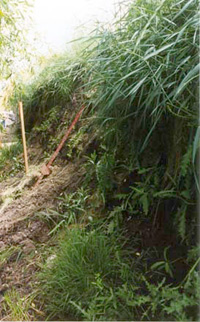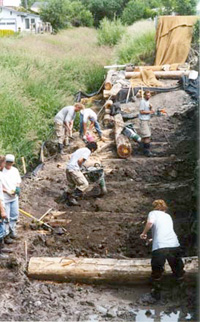 Watershed: Palouse Basin
Watershed: Palouse Basin
Stream Name: Paradise Creek
Date Established: 06/01/1999
Project Status: Complete, Ongoing monitoring
Overview
PCEI worked with a landowner within the Paradise Creek watershed to help them reduce erosion on their property and improve water quality through implementation of streambank revegetation and/or stabilization activities. In 1999, PCEI worked with urban landowners to construct a log wall revetment and coir log terraces. Riparian vegetation was then planted to provide shade, pollutant filtering, and wildlife habitat benefits.
Description
A seven foot high log crib wall revetment structure was installed along a 140 foot section of streambank located on the McGinty property. Construction of this wall will prevent additional scouring of the severely eroding streambanks caused by heavy flow events and a concrete wall placed in the floodway upstream of the McGinty property.
Construction methods:
- A silt barrier was installed downstream of the construction site.
- Footer trenches, approximately 2 feet wide and 7 feet long, were excavated every 8 feet along the streambank, 1 foot below the streambed.
- Trenches were filled with rubble rock, generally 6-12 inches in diameter.
- Footer logs were installed on top of the rock and fastened into place with rebar. Additional rubble rock was placed around the base of the footer logs.
- Cover logs were installed by positioning the joints over the footer logs and fastening to footer logs with spikes.
- Trenches were dug for the tie logs, the tie logs will be installed, then the tie logs were attached to the cover log using spikes or rebar.
- Face logs were cut and placed in position between the tie logs, then fastened to cover logs with spikes.
- Filter fabric were placed against the revetment, stapled to the logs, then backfilled with rubble rock and fill soil (rubble rock on bottom, fill soil on top).
- Disturbed soil was reseeded with grass to prevent future erosion.
- Woody vegetation was placed along the revetments steps to provide additional stabilization to the bank and increase fish and wildlife habitat along the creek.
Previous Conditions
Bank was highly unstable with large sections of bank collapsing each year.
Photo History:
 Before Picture: Typical cross sectional view of eroding streambanks. On this property, the landowner had lost approximately 4 feet of backyard to erosion and was situated to lose more.
Before Picture: Typical cross sectional view of eroding streambanks. On this property, the landowner had lost approximately 4 feet of backyard to erosion and was situated to lose more.
 Many Hands Make Light Work: AmeriCorps*NCCC team in action to construct a log crib wall revetment. The foundation of the wall has been excavated and is being installed.
Many Hands Make Light Work: AmeriCorps*NCCC team in action to construct a log crib wall revetment. The foundation of the wall has been excavated and is being installed.
 AmeriCorps*NCCC Members Team Up To Strike Rebar Through Cedar Logs: An industrial-sized drill was required to create a hole in the logs prior to the insertion of the rebar.
AmeriCorps*NCCC Members Team Up To Strike Rebar Through Cedar Logs: An industrial-sized drill was required to create a hole in the logs prior to the insertion of the rebar.
 Completed Log Crib Wall Revetment: Finished log wall measures 140 feet long and approximately 8 feet high. It will prevent erosion and thereby reduce sedimentation; a benefit to both the landowner and the community. Wetland plants were installed at the toe of the wall and riparian species of trees and shrubs native to Idaho were planted above the wall (trees & shrubs not shown).
Completed Log Crib Wall Revetment: Finished log wall measures 140 feet long and approximately 8 feet high. It will prevent erosion and thereby reduce sedimentation; a benefit to both the landowner and the community. Wetland plants were installed at the toe of the wall and riparian species of trees and shrubs native to Idaho were planted above the wall (trees & shrubs not shown).